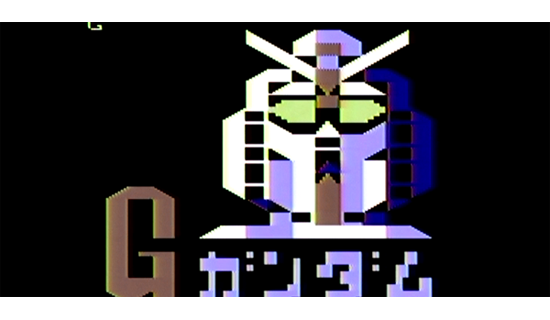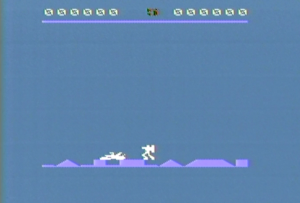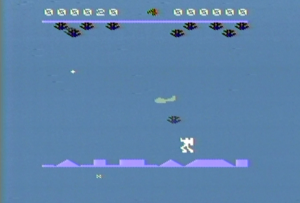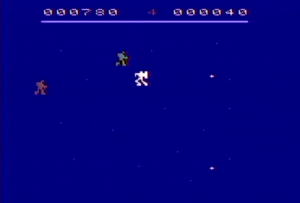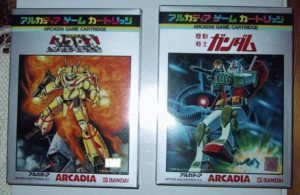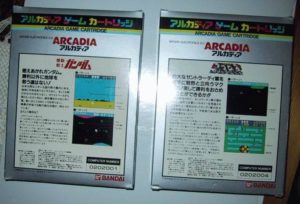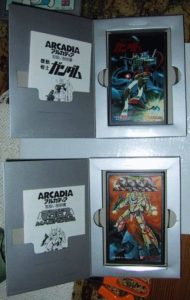The very first Gundam home console game was released in the height of Gundam-mania: A few years after the original TV series had wrapped up, approximately one year after the third and final compilation movie had hit theaters, but still a few years before Zeta Gundam (the second major TV series in the franchise) had begun. It debuted on a very unconventional piece of hardware for a Japanese game: The Bandai Arcadia. This was the variant of Emerson’s Arcadia 2001 console that was manufactured by Bandai for the Japanese market (each country had its own version of the hardware, manufactured by a different company). The release date is believed to have been sometime in May 1983, and the retail price 3800 yen, though no official data seems to exist on either of these points. This was still a pre-Famicom market in Japan, and release dates weren’t as carefully tracked.
And since this was on pre-Famicom hardware, our first Gundam game was a much more primitive one than what we would end up seeing on the Famicom several years later. After a title screen that features an impressive rendering of a Gundam head (The title screen reads “G Gundam”, but this is not a G Gundam game. That TV series would not debut until 1994, and early Gundam logos often had a large G just to the left of the katakana rendering of “Gundam”), the game begins with a ship flying across the bottom of the screen (it’s probably White Base) and producing a robot that is presumably the original RX Gundam (though not a very convincing representation of one), all while playing a rendition of the Gundam TV series opening theme song “Tobe! Gundam” that repeats throughout.
The game play is very simple, as you might expect of a game of this vintage: You move the Gundam using the joystick, found on the bottom of the unwieldy Arcadia controller, which was designed in the style of the Intellivision controller to feature a full numeric keypad. The Gundam’s beam rifle is fired with either of the buttons found on the sides of the controller, and always in the direction that you’re moving. This gives the player the ability to fire in all eight directions. This is no Space Invaders style shooter, you can move all around the screen.
There are only two screens to be found in the game, and they continuously loop after each other. The game manual states that the first screen involves you dodging Magella/Mazella Attacks from above, along with DOPP and GAW from the sides, while using your beam rifle to destroy them and earn points. After achieving a fixed score, the game advances to the second screen. Here you’re facing off against Zaku, Musai, and even Char’s special Zaku (the ones that are colored red). Clearly you’ve moved into space on the second screen, since the background has stars.
Since the game sprites don’t actually resemble their Gundam series counterparts after the head on title screen, many believe that this was a slight re-skinning of a previous Arcadia title. Though no one has identified what title it may be, it seems like it could be true. It’s not too hard to imagine a Bandai executive saying “Make some of those enemy sprites red, and ship it!”.
Since Arcadia hardware and software are not the easiest things to find these days, there have been different multi-carts released that attempted to collect the various games released for the hardware across multiple regions, which of course contain ROMs. The Arcadia 2001 Yahoo Group has discovered that there were both good and bad ROM dumps of Kidou Senshi Gundam, and there are behavior differences between the two. A bad ROM dump will play music only on the title screen, and none at all during the game. The later good ROM dump will play music during game play, but not at the title screen. Video of the game being played with an original cartridge and on original hardware that confirms this is the correct behavior can be found below.
Since it’s so simplistic, there isn’t much to say about this first Gundam game. It isn’t anywhere near as innovative as the next game would be, and is a similar experience to any early shooter on a pre-NES/Famicom console. If I’d been shown footage from the game with no context and asked what I thought it was, I definitely wouldn’t have said that it was a Gundam game though. It’s certainly not a bad game, it just doesn’t do anything to stand out. Even die hard Gundam fans shouldn’t feel the need to play this, and can probably make due with simply watching one of the few game play videos on youtube (linked below). Thanks to Kevin Bunch for letting me play this on original Leisure-Vision (the Canadian version of the Arcadia 2001) hardware!
(Footage of Kevin and I playing both the Gundam and Macross games for the Arcadia)
(Original Japanese Arcadia hardware playing a Kidou Senshi Gundam cartridge)
